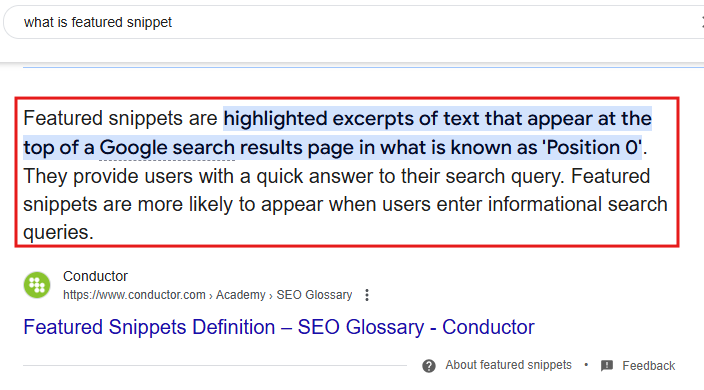Have you ever noticed that sometimes, when you search for something on Google, a box at the top of the search results gives you the exact answer you were looking for? That is called a featured snippet! It is Google’s way of providing quick and precise suggestions and answers to user’s search keywords. Featured snippets can be paragraphs, lists, tables, or even videos, depending on what the search engine thinks is the best way to answer a query. That way, the users don’t have to go to different websites, and they can get the answer right in Google’s search tab.

So, why are featured snippets important for bloggers and website owners? Well, they appear above all the organic search results, which is called “Position 0.” That means if you can optimize your blog posts for featured snippets, your content has a higher chance of being seen by more people. Featured snippets can improve your visibility and trustworthiness because people trust the first thing they see. A lot of users might get the answer they need without clicking through. However, many of them would also want to visit the website. That’s why we will share some practical and easy-to-understand strategies that can help you optimize your blog posts for these coveted snippets.
What Exactly Are Featured Snippets?
In simple terms, a featured snippet summarizes an answer to a user’s question. It is displayed right at the top of Google’s search results. These snippets are usually short and to the point. They quickly give users relevant information so they don’t have to scroll through multiple results to find what they want. Featured snippets can come in various formats, such as paragraphs or blocks of text answering a specific question. Lists that can be bulleted or numbered show steps or items, or a table shows data trends or comparisons.
Google gets this information from websites it considers trustworthy and relevant. That is why being featured in a snippet not only boosts visibility but also adds credibility to your blog. Research shows more than 12% of all search results show a featured snippet. Your blog post has a huge opportunity to take one of those most-wanted and sought-after spots.
Why Are Featured Snippets So Valuable?
Featured snippets hold a lot of value for both businesses and individuals. For one, they put your content right where you want it to be, i.e., front and on the top. Even if you’re not ranking as the top organic result, a featured snippet can give you more exposure than even the #1 spot. Research shows that featured snippets have a click-through rate (CTR) of about 8.6%, which is pretty impressive considering they appear above the organic results.
Featured snippets also establish your blog as an authority in your niche. When Google chooses your content for a snippet, it is as good as an endorsement from Google itself. Users are more likely to trust your information, and they might revisit your website in the future. Snippets are also mobile-friendly. With so many people using their phones to search, appearing in a featured snippet means your content will be one of the first things they see. So, blog optimization for Google snippets is basically a golden opportunity to be seen, read, and trusted by your target audience.
How Do Featured Snippets Work
If it wants to feature you, Google scans your blog for the most relevant answer to a user query. But how does Google know which part of your blog to feature? It all depends on the structure and relevance of your content. Google’s algorithm looks for clear, precise answers that can directly answer a user’s search question.
For example, if someone searches for “how to make a chocolate cake,” Google will look for a blog post that provides step-by-step instructions. If your post has a section with clear steps like “Step 1: Mix Your Dry Ingredients,” “Step 2: Combine them with Wet Ingredients,” or “Step 3: Preheat Your Oven,” Google might use this information to create a featured snippet.
The important thing to remember is that featured snippets depend heavily on how relevant your content is to the question. If your content is well written and answers match what people are searching for, you will probably be chosen for that snippet.
How to Structure Your Blog for Featured Snippets
A good structure makes your blog post more scannable, increasing your chances of appearing in a snippet. It is the simplest formula for organizing your information so it is easy to find, both for readers and search engines. You can do that by using clear headers. Each section of your blog post should have a header (H2 or H3) describing the content. This helps Google understand the layout of your blog and identify sections that might answer specific queries.
For example, if you’re writing a blog post on “How to Create a Marketing Plan,” use headers like “What is a Marketing Plan?” and “Steps to Create a Marketing Plan.” Under each of these, provide a clear and uncomplicated answer. You can also use different formats like bullet points and numbered lists. Google actually prefers pulling information from lists for featured snippets.
The Power of Long-Tail Keywords
Long-tail keywords are the major part of optimizing for featured snippets. These are specific phrases that people use when they’re closer to making a decision or when they’re asking a very specific question. For example, instead of “best laptops,” a long-tail keyword would be “best laptops for graphic design under $1000. Long-tail keywords usually have a lower competition and a higher chance of triggering a featured snippet. They are also specific, so they are closely related to user intent. That means the answers are more direct and easier for Google to feature in a snippet. That is why you should integrate long-tail keywords your audience might use when creating content.
Mobile Optimization in Featured Snippets
Over half of all Google searches happen on mobile devices. That means your content must also be mobile-friendly if you want it to be featured. Think about the last time you searched for something on your phone. Did you click through to the tenth result or just check out the snippet at the top? That is exactly what many users do, so optimizing for mobile snippets is extremely important.
A mobile-friendly blog is not just a responsive design. You need to ensure that your content is high quality but loads quickly, is easy to read on small screens, and presents information in an easily readable format. People using mobile devices usually look for fast answers, and Google prioritizes snippets that provide those answers in an easy-to-understand format.
Refreshing Your Old Blog Posts for Snippets
You don’t need to create brand-new content all the time to get a featured snippet. Sometimes, simply refreshing an older blog post can also work. You can increase your chances of getting featured by updating the information, changing the layouts of paragraphs, and citing newer statistics. When you want to revise an older post, check if there are opportunities to answer user questions more clearly. Can you add a list where there’s currently a paragraph? Can you improve the readability by shortening sentences or reformatting the content? This strategy has worked wonders for many bloggers. That is how you can recycle your older content to get featured snippets from Google.
Use Accurate Data and Examples
Google likes facts better than assumptions. If your content includes data, statistics, or real-life examples, you’re in a better position to get a featured snippet. Evidence-based content also performs well because it provides users with trustworthy and authoritative information. For example, if your blog post is about the benefits of meditation, include specific statistics like “meditation reduces stress by 40%.” Numbers add credibility to your content and make it more appealing to both Google and readers.
Real-life examples can also increase your chances of being featured. For example, if you’re explaining how to incorporate a new marketing strategy, include examples of companies that have successfully used the same approach and how they have used it. So, your plan or method is also proven by a previously successful implementation by a well-known company. For example, the reader is likelier to use your recommended strategy about including social corporate responsibility if you add examples of Toms, the shoe brand. They started by offering to donate a pair of shoes to the deserving on the purchase of a pair. After criticism of this strategy, they changed it. Now, they donate a big portion of their profits to different charities instead of donating based on consumer purchases.
Monitor, Change, and Adjust Your Strategy
Once you’ve optimized your blog posts for featured snippets, you need to keep going back and periodically revising your content. SEO strategies constantly change, and tools like Google Search Console can show you which queries are triggering snippets for your content. If one of your posts isn’t performing as well as expected, make changes according to the latest updates and track its performance.
For example, you might notice that a blog post on “how to improve work-life balance” is ranking well, but it’s not appearing in a snippet. Check the structure of your content. You should recheck if the answers are clear and if you use lists or bullet points where there’s a need. By making these small changes, you can improve your chances of getting your own featured snippet.
Conclusion
Optimizing your blog posts for featured snippets requires a well-researched and creative strategy. If you edit the structures of your content with verified long-tail keywords and keep the content highly and easily readable, you can increase your chances of getting that coveted “Position 0” on Google.
Whether you’re an experienced blogger or just starting as a content writer, these techniques will make your brand more visible and your content more accessible to a wider audience. If you need any help, you can always contact one of our SEO experts. At bmymarketer’s blog, we consistently update our techniques and use the best SEO practices to create our written content. Our SEO content writers and bloggers are experts in the industry from whom you can consult about your methods or even get an audit done. We will bring you to that search bar with our tried and tested strategies and apply them to your blog.








